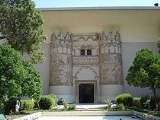
National Museum of Damascus
Encyclopedia
The National Museum of Damascus is a large museum in the heart of Damascus
, Syria
. The most popular part of the museum is the reconstruction of the 2nd century CE Dura-Europos synagogue
.
Complex.
It also contains many exhibits made of glass and metal, as well as coins, from different periods of Islamic History. There are also scriptures from the Ummayad era to the Ottomans.
There is also a hall containing an example of a traditional Syrian home, which was obtained from an old house which goes back to the 18th century.
There is a library adjacent to this section.
Damascus
Damascus , commonly known in Syria as Al Sham , and as the City of Jasmine , is the capital and the second largest city of Syria after Aleppo, both are part of the country's 14 governorates. In addition to being one of the oldest continuously inhabited cities in the world, Damascus is a major...
, Syria
Syria
Syria , officially the Syrian Arab Republic , is a country in Western Asia, bordering Lebanon and the Mediterranean Sea to the West, Turkey to the north, Iraq to the east, Jordan to the south, and Israel to the southwest....
. The most popular part of the museum is the reconstruction of the 2nd century CE Dura-Europos synagogue
Dura-Europos synagogue
The Dura-Europos synagogue is an ancient synagogue uncovered at Dura-Europos, Syria, in 1932. The last phase of construction was dated by an Aramaic inscription to 244 CE, making it one of the oldest synagogues in the world...
.
Location
The National Museum of Damascus lies in the West of the City, between the Damascus University and the Tekkiye MosqueTekkiye Mosque
The Tekkiye Mosque is a mosque complex in Damascus, Syria, located on the banks of the Barada River. The complex is composed of a large mosque on the southwest side of a courtyard, flanked by a single line of arcaded cells, and a soup kitchen across the courtyard to the northwest, flanked by...
Complex.
History
Collection of exhibits began in 1919, and the current building was constructed in 1936, with wings being added in 1956 and 1975.Ancient Syria
Many Exhibits from ancient sites such as Ebla. The most important of these is the world's first Alphabet.Classical Age
This wing contains Roman, Greek and Byzantine exhibits. It includes many rare statues, as well as stone and marble sarcophagi. It also includes a jewellery section, and many other exhibits which may not be found in any other part of the world.Islamic Age
The facade of an Islamic palace has been moved and reconstructed as the museum's main entrance. Some of the contents of the palace are also located in the museum, including carvings.It also contains many exhibits made of glass and metal, as well as coins, from different periods of Islamic History. There are also scriptures from the Ummayad era to the Ottomans.
There is also a hall containing an example of a traditional Syrian home, which was obtained from an old house which goes back to the 18th century.
There is a library adjacent to this section.

